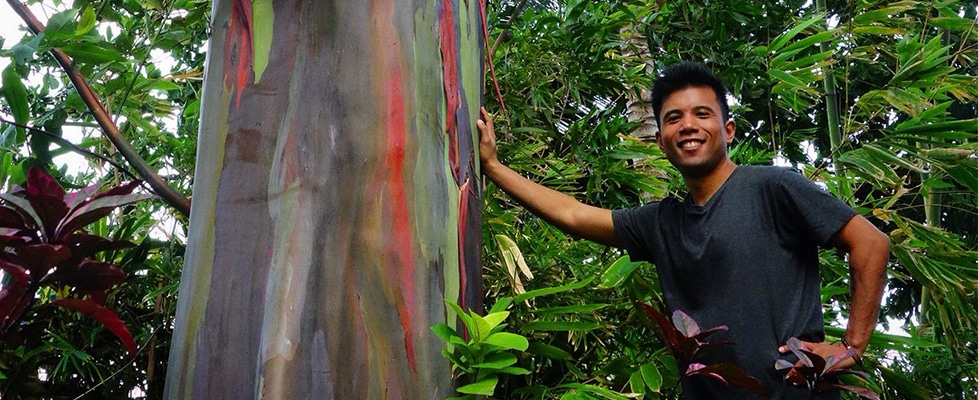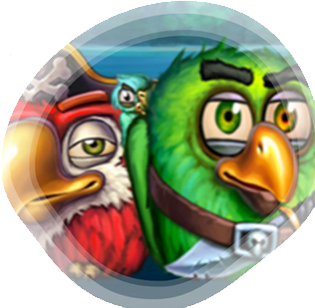Haribon Foundation Interview
How much do you value fresh air and water?
If the answer is “a lot”, you should definitely listen to our latest interview with The Haribon Foundation.
Find out why biodiversity conservation is vital to our wellbeing and what this organization is doing to stop the death of natural habitats in the Philippines.
Listen here or find us on your favorite podcast app.
November 17, 2020
Why Should We Care About the Destruction of Natural Habitats?

Why Should We Care About the Destruction of Natural Habitats?
Rainforests around the world are receding. In the 1900s, around 70% of the Philippines was covered in forest. Now it's less than 23%.
The Narra Tree, a once abundant national symbol, recently became endangered. In this episode, we talked to Albert Balbutin from Haribon Foundation - a nature conservation organization in the Philippines - about the vital importance of managing our natural resources.
Haribon specializes in biodiversity conservation; it works with local communities to look after marine and land habitats for everyone's well-being and enjoyment. The Haring Ibon, an eagle found in Philippine forests, inspires its name and logo. Albert explains that it is important to use animal images to raise awareness of habitat loss because they strike an emotional chord with people. He hopes that instead of asking how to save the animals themselves, we will start asking how to save their habitats.
How are communities affected by habitat conservation?
Many people don't realise how resources we rely on come directly from natural habitats. In Manila, the capital, over 90% of the water comes from the Sierra Madre mountain range to the north of the city; but this forest habitat is at risk of encroachment.
Even though there are restrictions in place to protect forests from loggers, the legal framework is complicated and corruption rife. Many take advantage of policies from the colonial period, which focus on extraction of resources rather than conservation. Albert stresses the importance of protecting these forests for oxygen production, carbon dioxide absorption and the stability of the water table. We shouldn't take fresh air and water for granted!
What sort of programs is Haribon running?
Haribon has reached over 60,000 students throughout the country. It teaches them about native flora such as the Banaba Tree as part of their Forest Friends campaign and runs an educational roadshow through its Biodiversity on Wheels program.
Then there is Women Go, a campaign funded by the EU to inspire more women to become active conservationists. It has engaged the community through poetry; one reads "Magkaiba man ang kababaihan noon at ngayon" (Women then were different to now).
How can you get involved?
You can donate to Haribon directly through the Adopt-a-seedling program. For seven US dollars your tree will be planted and maintained by local communities. So far, Haribon has planted almost 1 million.
Conservation is a global effort, so you can also support a conservation organization that is closer to home. After all, what happens in one part of the world is going to affect everywhere else!
Want to learn more about The Haribon Foundation? You can subscribe to their newsletter, checkout their news section and follow them on Facebook, Instagram and Twitter.
Great.com was founded in 2017 with the goal of generating donations to stop climate change. The organization operates within the typically uncharitable online casino industry, where it tries to create something good out of something sometimes harmful. Great.com generates profits by competing with traditional casino companies in Google search rankings for online gaming signups coming from search terms such as "online roulette" and "best online casino NJ". All profits are then donated towards causes fighting against climate change. So far we have generated donations of over $1.3 million.
[00:00:00]
Every day you and I get bombarded with negative news. Just like the body becomes what we eat, the mind becomes what we’re putting in. It is important to listen to stories that not only give you hope, but also inspire you and uplift you.
[00:00:17]
In this podcast, we’re interviewing experts who will break down the solutions to the world’s most pressing problems. And I promise you, if you listen to this podcast, you’ll not only stay informed but you will also feel more energy in your life. Welcome to Great.com Talks With.
[00:00:43]
The topic of today is how do we conserve nature and why is nature conservation important? And if you want to contribute to protecting the planet Earth, make sure you like and subscribe to our channel, because great dotcom is donating 100 percent of our profit directly towards the most effective areas like climate change technology or saving to the rainforest. And today we have invited Albert Balbutin, who we’re going to talk to about conservation, because the organization that Albert is working for has been doing conservation work since 1972. And before I reveal the name of that organization, I want to give you an easy way to remember the name. At least I think it’s easy.
[00:01:29]
And that is. Who is the king of birds? It’s the eagle, and so the name of this organization is called Haribon Foundation, which is a synonym or it’s the same name as King of Eagles in the Philippines.
[00:01:47]
So, Albert, welcome to this episode of.
[00:01:51]
Thank you, sir. Thank you for having us.
[00:01:56]
If we talk about the problem that you guys are trying to solve, you’re doing conservation around birds, marine rainforest, what would you say that the problem is that you’re trying to solve?
[00:02:13]
Well, there are a number of problems, and one of them is habitat loss, which affects our species here in the Philippines, which are considered one of the mega diverse countries in the world. And unfortunately, despite that, there isn’t a lot of awareness about the importance of biodiversity. And on top of that, we have forest habitats that are losing, our forest habitats are losing habitats according to coral bleaching and other factors hunting.
[00:02:45]
And so these are a few of the problems that we’re facing here in the Philippines that I believe also choose them.
[00:02:55]
Could you try holding your mind towards your mouth? Sure. Is that better? Yeah, much better. OK, Starbuck, I know where this is now. We’re on in the game. So what I’m hearing is one of the big problems is just awareness to help people to understand what’s going on with biodiversity around the world.
[00:03:19]
So tell us more about conservation. What is conservation?
[00:03:25]
Conservation is looking at the natural resources and doing what it takes to manage it properly with the help of local communities so that it’s sustainable for people to enjoy. And so natural resources like our forests. So here, for
for example, I live in Metro Manila, which is the biggest city in the Philippines. Over 90 percent of the water comes from the Sierra Madre, which is the longest mountain range in our country.
[00:03:53]
And so that’s a natural resource that needs to be sustained. But unfortunately, there are problems like encroachment into our forest habitats in the Sierra Madre, in this mountain range. And so this is something we like to tell people, especially in the big cities like Manila, that just because you’re in or you’re in, in an urban area, we still have natural resources like water, fresh air, the white beaches that we want to enjoy. All of that needs to be properly managed and or in a concert needs to all be conserved so we can continue to live happy lives and our children and our great grandchildren can continue to live happy lives as well.
[00:04:37]
Could you say, though, that conservation is very close to sustainability? Yeah, I would say so, yeah, definitely doing conservation work is doing and creating a sustainable system for whatever resources we’re using. Yes. And you’re then, if I understand it, you’re into three ways of conservation or even more marine birds and rainforest.
[00:05:02]
Yes, I would say that we we look at our species, we look at biodiversity, say, for example, the Philippine Eagle, which our organization is named after, that because people are quite visual and birds are some of the most beautiful species that you can just see and just look out your window and see a bird. So we take pictures and videos and we take data about these beautiful birds and we show that to them and we tell them not only should we be saving these birds, but we should also be saving their habitats. So that’s our connection, how we connect conservation to from biodiversity to these species like the Philippine Eagle to our natural resources.
[00:05:47]
It’s easier to understand the to increase awareness by shooting like the eagle as a symbol for.
[00:05:57]
Biodiversity, yes. It makes sense if you then look at it like you’re working directly in the Philippines and you have a lot of rainforest, right? Yeah. So I would be very profitable to save the rainforest there. For example, how big is the problem right now with rainforests being logged or burned down, I guess?
[00:06:22]
Unfortunately, according to the data back into the early nineteen hundreds, we were at about 70 percent forest cover in terms of area in the Philippines now where we are down to about twenty three percent. Twenty three to twenty four percent. Yeah. So we’re down to about a fourth left of this forest cover. And so much of this forest, as I mentioned before, like in the Sierra Madre, actually provides us with the water that we need at the water that’s used in irrigation in our agriculture. So that’s where we are today. In terms of forests, we’re down to twenty four percent, unfortunately.
[00:07:01]
When you, at least to me, living in Europe and in Sweden, I hear a lot of coverage from news about Brazil, that it goes quite rapidly, that the rainforests are being shut down partly because of the new president’s kind of bold scenario, who allows that kind of. Activities. And so I would focus not only on the rainforest in Brazil when I think of the rainforest. Um, is, um. Are we missing what’s going on in the Philippines, in Southeast Asia, when it comes to reinforcements, it almost sounds like it goes even faster. There is a more rapid pace of logging the rainforest.
[00:07:50]
Yeah, I’m not quite sure compared to the rate of loss in Brazil, definitely in the Amazon. They have a greater area of forest here in the Philippines because of the insular makeup. We have a lot less land. I guess in one perspective, you can say that the forest here is even more precious, if anything, to two Filipinos in the Philippines because we don’t have that much land. And to know that we’re down to just one fourth of we had before and these small islands is is quite concerning not only to us, but it should be concerning concerning to everyone, especially when there are species and biodiversity here in the Philippines, that in our forest alone that you can’t find in other countries, let alone Brazil or but India. For us, it doesn’t matter where or where you are. It doesn’t matter the rate of loss. All that matters is that closely, whether you’re Brazilian or Filipino or or in Europe or in the US, that you really find that connection to the environment and do what you can to help wherever you are, because what happens in one part of the world is going to affect everyone else. And you can see that when you look into climate change, all these issues where people are doing things on one part of the globe, on one part of the globe or one part of a continent or a country will eventually affect people outside of that area.
[00:09:20]
I think that’s why there’s been a lot of people who started Carad lately, because we realized, OK, we’re all connected.
[00:09:30]
My question was more about the regulations. And the politics is how is the Philippines politics? There’s no restrictions. People can do whatever they want. Are there restrictions coming?
[00:09:43]
What does the environment for the rainforest look like at the moment?
[00:09:48]
Currently, our policies on paper are near perfect. They read great. Unfortunately, the implementation is poor. We have rampant corruption. We also have and unfortunately, speaking of policies, even though more of our newer policies, our modern policies are good on paper in terms of environmental policies, we still have our policies and very old policies in which focus more on extraction rather than conservation. So, for example, and a lot of these log these lies run back to the colonial period. So if you review some of the logs from Spanish colonization, a lot of the laws that dictate our forests and land use are really extraordinary in nature, meaning they’re all just about cultivating the forest and taking it and taking it abroad back then to Spain or international economies. And then when the US came around, it was the same thing. The policies were contractionary in nature and even policies from the nineteen hundreds onward. We have mining policies. We have policies on forest management that weren’t really management at all. It was really just cutting the trees down and how to manage that. It incorporated the forest law today in the Philippines that includes forest plantations. But in reality a forest is a living ecosystem that shouldn’t be a source of extraction just for wood. I mean, it’s important people need to survive and there’s livelihood there and there’s an economy there. But at the same time, there has to be some force left alone to sustain and supply us with not only wood, but carbon sequestration, oxygen and with the water that we need through the water table and watersheds and so on and so forth. So unfortunately, a lot of these policies don’t reflect this. So that that’s just done on the topic of policy.
[00:12:03]
I find it interesting that at least on paper, everything looks, the restrictions are on the forest, looks good, and because that’s not always the case. But then I do see then the value of the work that you would do, you are actually doing the actual conservation, the actual implementation that you’re saying and this is missing. So I guess that is part of the problem that you’re solving.
[00:12:29]
Implementation of the implementation, making sure that communities are involved in the policy making for these for these things so that they are not they are not left out of the equation when it comes to conservation, tell us then, what would you suggest that people listening to this and to you, what would you suggest people do if they if they live in the Philippines or if they don’t live in Philippines?
[00:12:54]
What would you want people to do?
[00:12:57]
I want them to get involved with the local organization, even if you’re outside of the Philippines. Well, specifically sorry, an environmental organization in your local area that works in your local area, just so you can get to know what they’re about, what they’re focused on, what are the local issues? What are the environmental issues around you? I think that’s a good start. And when I say support or get involved, it’s really up to you. It could be a monthly donation, but even better, if these organizations have some sort of membership or training programs or volunteer programs, maybe have people in your family get involved, get to know them. I mean, nowadays, people are more aware in the digital realm where we’re doing things remotely, maybe they’re doing webinars. Maybe you can get to know these local organizations and the issues that they’re tackling via the Web. That’s probably a good start. And, yeah, that’s that’s always something that we encourage people to do.
[00:13:59]
Hmm, tell us more about the work that you guys are doing.
[00:14:05]
Do you have any specific project in mind that you think is interesting to highlight?
[00:14:09]
Well, since we’re talking about forests, we do have a program called it’s more of a part of a movement called Forests for Life. And it was founded back in around the mid twenty two thousand five. And what it is, is it’s a network of people, scientists, everyday people, students who are really concerned about our forest loss here in the Philippines and are getting involved and planting trees. And what we do is we not only register people or include people or enroll people who are doing their own tree planting activities in their own area. But we also collect donations to conduct tree planting activities every year. And one of the programs under this movement is called the Adopt a Seeding Program so people can actually adopt this evening and give our local currency three hundred fifty pesos, which is more or less around seven to eight dollars us. And with that single adoption that not only goes to the planting of the tree, but it also goes to the maintenance of that tree by local communities on the ground who live in that area. So those are just one of the programs we have in trying to tackle the issue for.
[00:15:29]
I read on the website that you guys already planted a million trees. Is that the number that you’re talking about?
[00:15:35]
Yes, so far, a million trees so far.
[00:15:37]
Now, that’s impressive. And you reach 60000 students. I guess that will be an environmental education, but you provide for these people.
[00:15:48]
Yeah, that’s another program where we go off to schools and in the country and we teach kids as young as in the elementary school, first grade up to to high school. And we bring biodiversity education and we bring these issues in a positive manner, teach them about ecology, about biodiversity, about the unique species in the Philippines. Yeah.
[00:16:13]
And the one thing that I found was unique and cool, but I’ve not seen before is you call it biodiversity on wheels. So can you tell us more about what biodiversity is on wheels?
[00:16:26]
So biodiversity on wheels is exactly that. It’s what we call our mobile classroom. So it’s this little van packed with different materials, books, stickers and has a little TV and we go to different schools. And that’s our basic vehicle to take biodiversity education to these different classrooms. So say, for example, we visit a school on another island and we arrive at the school. The van opens up, has these two good column wings. Both sides open up on one side, there’s a TV and another there’s we have books and we have volunteers who help out each session and do storytelling and teach the kids about biodiversity and other topics that I mentioned earlier.
[00:17:13]
Yeah, basically, I’m hearing make it more fun to to learn about the environment, you would get, uh, quite a broad and easy to to talk to many, many school kids about the environment. Yeah, that really looks really cool when you look at the pictures. Um, great. So. That is the kind of the short term deal that we do today to better understand your organization and the work that you’re doing. I would like to end this by asking you. Is there anything that you think is extra important for people, for more people to understand that you would like people to to really understand?
[00:18:00]
I guess when we say conservation or conserving the environment, what we’re also saying is that we are conserving ourselves. And what’s what really surprises me personally is that this knowledge of conserving what we have is actually a very old concept. This is something that’s been championed and still championed by, say, our indigenous peoples, especially our indigenous peoples here in the Philippines. So in a way, you can say that we’re not telling people to do something new and to conserve, but we’re reminding people about the importance of the environment, something that unfortunately our society has long forgotten. And we believe that this has to be done not only to save the Philippine Eagle and all these other wonderful species, but to save one of the most important species, which is ourselves, Homo sapiens.
END OF TRANSCRIPT



